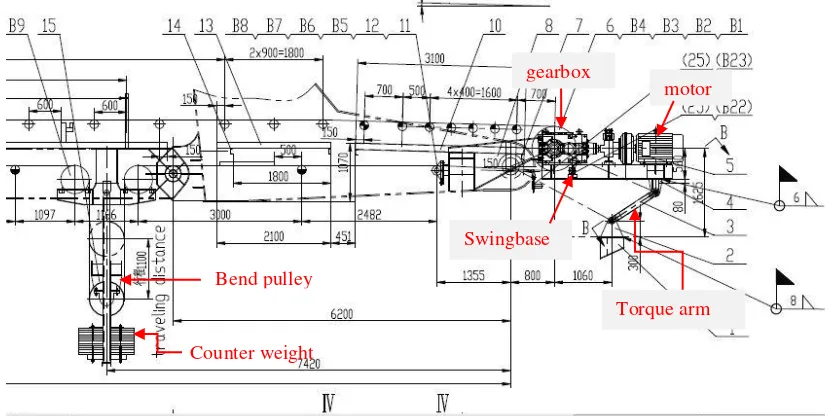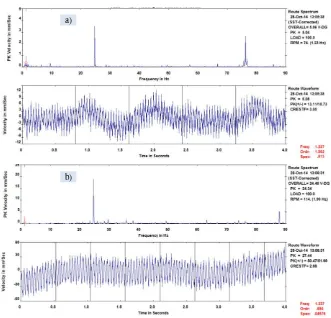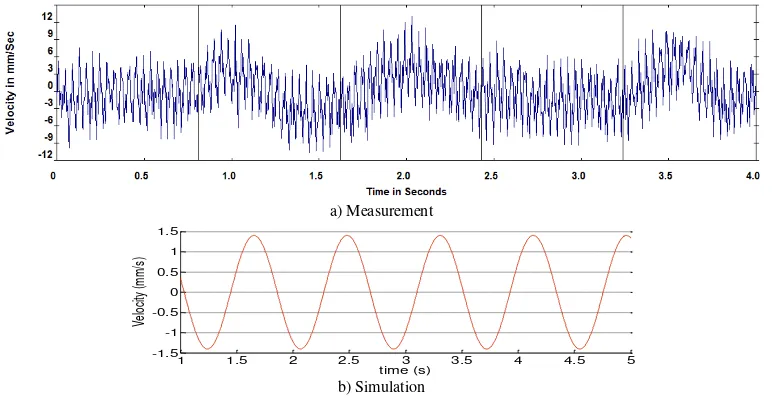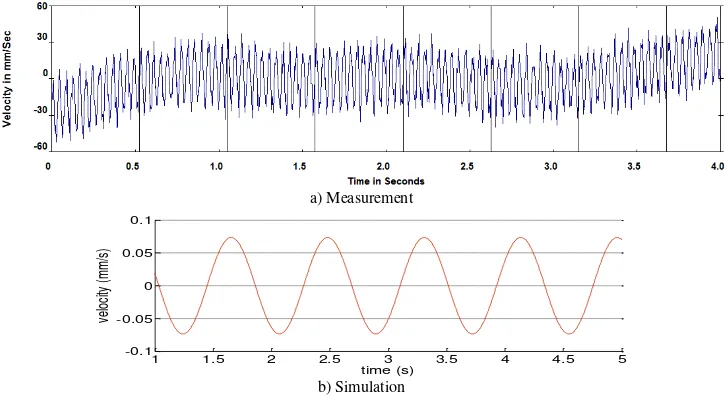Vibration Monitoring and Analysis of Conveyor
Driving Unit of a Coal Transporter
Harus Laksana Guntur
1and Yanuar Krisnahadi
1Abstract This paper presents the result of vibration monitoring, simulation and the analysis of conveyor driving unit of a coal transporter. In steam power plant, coal transporter is on of the fundamental equiptment for coal handling and energy supply. Conveyor driving unit (CDU) is the unit in a coal tranporter which drive the conveyor and transport coal from the stockpile/coal yard to the burner. CDU failure cause instability in coal handling process and influence the production capacity of the power plant. To maintain the reliability of the coal transporter, vibration based condition monitoring is conducted. The vibration of CDU is affected by the tranported load, luffing angle and conveying rate. In this paper, the report is focused on the vibration monitoring result and analysis of the influence of the luffing angle and conveying rate (transported load) to the vibration.The CDU is mathematically modeled and its vibration is simulated. Here, conveyor belt tension at driver pulley is assumed to be the main source of vibration,which has frequency of 1.237Hz. Measurement results show that maximum amplitude occurs at frequency of 24.5 Hz, which is closed to the driving motor of the conveyor. The simulation results show that bigger luffing angle and conveying rate increase the vibration amplitude, specifically at horizontal (x) direction.
Keywordsvibration monitoring, conveyor dring unit, coal handling, coal transporter.
AbstrakMakalah ini menyajikan hasil pemantauan getaran, simulasi dan analisis unit penggerak konveyor pengangkut batubara. Di pembangkit listrik tenaga uap, pengangkut batubara merupakan peralatan fundamental untuk penanganan batu bara dan pasokan energi. Unit penggerak konveyor (CDU) adalah unit pengangkut batubara yang menggerakkan konveyor dan mengangkut batubara dari stockpile / coal yard ke burner. Kegagalan CDU menyebabkan ketidakstabilan proses penanganan batubara dan mempengaruhi kapasitas produksi pembangkit listrik. Untuk menjaga keandalan transporter batubara, pemantauan kondisi berbasis getaran dilakukan. Getaran CDU dipengaruhi oleh beban tranported, sudut luffing dan tingkat pengantaran. Dalam tulisan ini, laporan difokuskan pada hasil pemantauan getaran dan analisis pengaruh sudut luffing dan tingkat pengantaran (muatan yang diangkut) terhadap getaran. CDU dimodelkan secara matematis dan getarannya disimulasikan. Di sini, konveyor belt tension pada pulley pengemudi diasumsikan menjadi sumber utama getaran, yang memiliki frekuensi 1.237Hz. Hasil pengukuran menunjukkan bahwa amplitudo maksimum terjadi pada frekuensi 24,5 Hz, yang tertutup terhadap motor penggerak konveyor. Hasil simulasi menunjukkan bahwa sudut luffing dan laju pengangkatan yang lebih besar meningkatkan amplitudo getaran, khususnya pada arah horisontal (x).
Kata Kuncipemantauan getaran, unit conveyer, penanganan batubara, pengangkut batubara.
I. INTRODUCTION1
oal handling system is needed to guarantee the production process of electricity in a Steam-Electric Power Generating Plant. Coal handling system has two main processes, i.e.: loading process and unloading process. Loading process is the process of coal loading from stockpile into coal bunker. Unloading process is the process of coal transfer from ship into stockpile.
Coal Transporter or Stacker Reclaimer is the main unit in coal handling which transport coal from the stockpile/coalyard into the coal bunker and coal burner. During its operation, coal transporter can adjust the transported coal rate/capacity and the luffng angle at the stockpile. Failure in coal transporter can produce instability in coal handling process, which will affect to the decrease of coal handling capacity form 1100 t/h to 500 t/h and increase the production cost. To guarantee the reliability of the coal transporter, a steam-electric power plant implement a preventive maintenance (PM) and predictive maintenance (PdM). One of the PM is vibration monitoring and comparison with the baseline or trend. Vibration measurement and recording is carried out routinely during its operating time.
Yanuar Krisnahadi and Harus Laksana Guntur [1], reported a preliminary study on the influence of luffing angle and coal handling capacity on the vibration
1Harus Laksana Guntur and Yanuar Krisnahadi are with Department
of Mechanical Engineering, Institut Teknologi Sepuluh Nopember, Surabaya, 60111, Indonesia. E-mail: [email protected]
responses of a stacker reclaimer. Simulation and measurement was conducted to analyze the vibration trend and validate the model. The results show an initial information on how the vibration trend changes when the luffing angle and handling capacity change. Walter Bertelmus [2] carried out a dynamic modelling of gear box of a belt conveyor driving unit by varying non stationary load to detect the distributed fault. Two gear boxes are modelled, i.e. fixed-axis two-stage gearbox and planetary gearbox of belt conveyor and bucket wheel excavator. The results show that original transmission error is influenced by the technical condition and load values which is important in implementing condition monitoring.
Ghalamchi [10] studied simple and versatile dynamic model of spherical roller bearing. They reported partial study and investigation of the coal handling system component.
In this paper, the research is focused on the vibration monitoring result and analysis of the CDU of a coal handling system. The CDU is mathematically modeled and its vibration is simulated. The conveyor belt tension at driver pulley is assumed to be the main source of vibration. The simulation results and vibration measurement are compared and studied.
II. METHOD
The research is started by literature study and technical data collecting. Parameters and dimension of the CDU are measured and collected. The CDU and coal transporter parameters and dimension are used to develop the mathematical model and simulation. From the collected parameters and dimension, the mathematical model is governed and simulation block diagram is developed. Figure 1 and 2 show the detail drawing of the Conveyor driving unit (CDU) and coal transporter, which mainly consists of motor, gear box, conveyor, belt pulley, swing base, torque arm and counterweight.
A. Vibration measurement
CDU’s vibration measurement is carried out at various luffing angle 30 and 40, and at various conveying
rate 300 t/h and 500 t/h. Measurements are conducted at several point, i.e. drive pulley inboard bearing (DPIB) vertical, DPIB horizontal, drive pulley outboard (DPOB) vertital and DPOB horizontal.The real image of the CDU and coal tranporter, and can be seen in Figure 3(b). To analyze the trend of vibration response of the CDU, vibration monitoring/recording was also conducted daily based, in addition to the actual coal tranporting rate in ton per hour [t/h].
B. Mathematical modelling and simulation
Figure 4 shows the dynamical/mathematical model of the CDU, the damper and stiffness of the system, and the direction of the conveyor belt tension at driver pulley which is assumed to be the main source of vibration [4][5]. From the dynamical model of the CDU and free body force diagram [6-8], the dynamic equation are governed and the state variable form are shown in equation (1) to (7). equation (1) to (7). Table 1 to 3 are the parameters of the CDU used for the simulation .
Nomenclature:
F:Excitation force [N], J:moment of inertia [kg.m2], m:mass [kg], k:stiffness[N/m], c:damping coefficient [Ns/m], θ-β-γ :angular displacement[rad], L:length [m], x-y:translational displacement [m], 𝑥̇ − 𝑦̇:translational velocity [m/s], ω:angular velocity [rad/s], 𝑣̇:translational acceleration[m/s2], 𝜔̇:angular acceleration [rad/s2].
III. RESULTS AND DISCUSSION
A. Vibration and conveying rate measurement results Figure 5 shows the outborad vibration measurement report of the bearing pulley conveyor of coal transporter, from Dec 2012 - Jan 2014. The RMS velocity of the vibration increases from 2.4 mm/s to 2.8 mm/s and decrease to 2.2 mm/s within february-april-july 2013.The RMS velocity reach its peak at 4 mm/s in November frequency of the motor of the coal tranporter.
Figure 7 shows the CDU’s vibration responses at luffing angle 30 conveying rate 300 t/h : a) DPIB
horizontal, b) DPIB vertical. The frequency domain shows that peak velocity occurs at frequency of 25Hz, both for DPIB vertical and horizontal. The amplitude of vibration shown by its RMS velocity indicates that vibration at vertical direction is higher than at horizontal direction.Whereas the vibration responses of the CDU at luffing angle 30 conveying rate 300 t/h : a) DPOB
B. Comparison of vibration measurement and simulation results
Figure 9 to 12 show the comparison between vibration measurement and simulation results of the CDU at luffing angle 30 and conveying rate 300 t/h, DPIB
horizontal-vertical, and DPOB horizontal-vertical. In general, the simulation results show a single frequency response, whereas the measurement results show a multi frequency response. As vibration of a body is mainly influenced by the characteristic or frequency of the exciter (operating frequency) and its component’s natural frequency, it is difficult for modelling and simulation to show similar phenomena with the measurement results for complex system.
The summary of RMS velocity responses and the comparison between measurement and simulation results are seen in Figure 13 for DPIB horizontal-vertical and Figure 14 for DPOB horizontal-vertical. The vertical (Y) axis is for vibration RMS velocity[mm/s] and effective tension[N], while the horizontal (X) axis is for luffing angle and conveying rate [t/h], as detailed in Table 5 to 8. Table 5 and 6 for DPIB horizontal-vertical, and Table 7 and 8 for DPOB horizontal-vertical.From the figure and table, the effective tension of the conveyor increase 0.1 mm/s from 1(luffing angle 30 and conveying rate 300 t/h)
to 3(luffing angle 40 and conveying rate 300 t/h), for all
measuring position, DPIB horizontal-vertical and DPOB vertical-horizontal.Meanwhile, the vibration tends to be constant. The table show the difference between RMS velocity obtained from measurement and simulation ranging from minimum value of 1.9% to maximum value of 64.5%. Maximum 64.5% difference occurs due to inaccuracy in determining the parameter, several assumption and simplification for CDU, which is a complex system for modelling.
IV. CONCLUSION
The outborad vibration of the bearing pulley conveyor of coal transporter, from Dec 2012 - Jan 2014 show the RMS velocity of the vibration increases from 2.4 mm/s to 2.8 mm/s and decrease to 2.2 mm/s within february-april-july 2013.The RMS velocity reach its peak at 4 mm/s in November 2013. The actual coal conveying rate is fluctuated from 200 to 700 t/h, and has its RMS value of 300 t/h. Maximum vibration of 1.22 [mm/s] is found at luffing angle 30 and conveying rate 300 t/h, at DPIB
horizontal. The frequency domain shows that peak velocity occurs at frequency of 25Hz, both for DPIB vertical and horizontal. The amplitude of vibration shown by its RMS velocity indicates that vibration at vertical direction is higher than at horizontal direction.
The RMS velocity responses and the comparison between measurement and simulation results show that the effective tension of the conveyor increase 0.1 mm/s, from point 1(luffing angle 30 and conveying rate 300 t/h)
to 3(luffing angle 40 and conveying rate 300 t/h), for all
measuring position,whereas the vibration tends to be constant. The table show the difference between RMS velocity obtained from measurement and simulation ranging from minimum value of 1.9% to maximum value of 64.5%. Maximum 64.5% difference occurs due to inaccuracy in determining the parameter, several assumption and simplification for CDU, which is a complex system for modelling.
REFERENCES
[1] Yanuar K., H.L.Guntur,“Analisa Pengaruh Variasi Conveying Rate
dan Luffing Angle Terhadap Respon Getaran Mekanisme
Penggerak Konveyor Boom Pada Stacker Reclaimer PLTU Paiton Baru,” Seminar nasional getaran & akustik, UGM, 2014. [2] Abrate, Serge, Vibrations Of Belts And Belt Drives. Mech. Mach.
Theory, Vol. 27, pp. 645-659, 1991.
[3] Bartelmus, Walter,”Modelling of Gearbox Dynamics Under Time-Varying Nonstationary Load For Distributed Fault Detection And Diagnosis,” European Journal of Mechanics A/Solids, Vol.29, hal.637-646, 2010.
[4] Conveyor Equipment Manufacturers Association,” Belt Conveyors for Bulk Materials,” Engineering Conference: United States of America,2002.
[5] M. Musselman dan D. Djurdjanovic,”Tension monitoring in a belt-driven automated material handling system,” CIRP Journal of
Manufacturing Science and Technology,Vol. 5, pp 67–76, 2012.
[6] Frederick, Close,”Modeling and Analysis of Dynamic System,”John Wiley & Sons: USA, 1995.
[7] Kelly, S Graham,”Fundamental of Mechanical Vibrations,” McGraw-Hill International Editions,” Ohio, USA, 2000. [8] Rao, Singiresu S.,”Mechanical Vibration,”Prentice Hall PTR:
Singapore,2004.
[9] Selezneva, Aleksandra,”Modeling and Synthesis of Tracking Control for the Belt Drive System,”Mechanical Engineering Project, Lappeenranta University of Technology: Finland,2007. [10] Ghalamchi, Behnam,”Simple and Versatile Dynamic Model of
Figure. 1. Detail drawing of the coal transporter
Figure 2. Detail drawing of the Conveyor driving unit (CDU) and coal transporter
Figure 3. The real image of Conveyor driving unit (CDU) and coal transporter Counter weight
gearbox
motor
Swingbase
Bend pulley
Torque arm
Motor Gearbox
Swing base
Torque arm
DPOB horizontal base
Figure 4. Schematic image of the Conveyor driving unit (CDU)
Figure 5. Outborad vibration measurement report of the bearing pulley conveyor of coal transporter
Figure 6. Actual coal conveying rate transported by CDU 30, 300
t/ht/h
Figure 7. CDU’s vibration responses at luffing angle 30conveying rate 300 t/h : a) DPIB horizontal, b) DPIB vertical
Figure 8. CDU’s vibration responses at luffing angle 30conveying rate 300 t/h : a) DPOB horizontal, b) DPOB vertical
a)
b)
a)
a) Measurement
b) Simulation
Figure 9. CDU’s vibration responses at luffing angle 30conveying rate 300 t/h DPIB horizontal : a) Measurement, b) Simulation
a) Measurement
b) Simulation
Figure 10. CDU’s vibration responses at luffing angle 30conveying rate 300 t/h DPIB vertical : a) Measurement, b) Simulation
a) Measurement
b) Simulation
Figure 11. CDU’s vibration responses at luffing angle 30conveying rate 300 t/h DPOB horizontal : a) Measurement, b) Simulation
1 1.5 2 2.5 3 3.5 4 4.5 5
-1.5 -1 -0.5 0 0.5 1 1.5
Velo
cit
y
(m
m
/s
)
time (s)
1 1.5 2 2.5 3 3.5 4 4.5 5
-0.1 -0.05 0 0.05 0.1
veloc
ity
(m
m
/s
)
time (s)
1 1.5 2 2.5 3 3.5 4 4.5 5
-1.5 -1 -0.5 0 0.5 1 1.5
Velo
cit
y
(m
m
/s
)
a) Measurement
b) Simulation
Figure 12. CDU’s vibration responses at luffing angle 30conveying rate 300 t/h DPOB vertical : a) Measurement, b) Simulation
Figure 13. The comparison of RMS velocity obtained from measurement & simulation, and the effective tension at (a) DPIB horizontal, (b) DPIB vertical
Figure 14. The comparison of RMS velocity obtained from measurement & simulation, and the effective tension at (a) DPOB horizontal, (b) DPOB vertical
TABLE 1. CONVEYOR PARAMETERS
TABLE 2. GEAR BOX PARAMETERS
TABLE 3. MOTOR SPECIFICATION
1 1.5 2 2.5 3 3.5 4 4.5 5
-0.1 -0.05 0 0.05 0.1
veloc
ity
(m
m
/s
)
time (s)
(a)
(b)
(a)
TABLE 4.
Horizontal Vertical Horizontal Vertical




